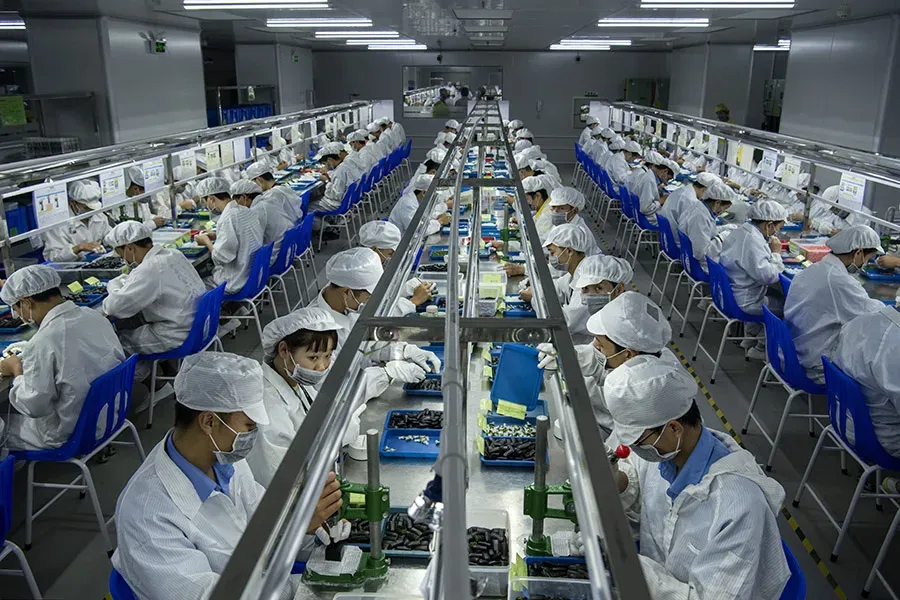As Chinese factories halt production amid escalating trade tensions with the U.S., the manufacturing landscape is undergoing significant changes. The impact of U.S. tariffs is rippling through the economy, forcing many Chinese manufacturers to pause operations and search for new markets. With lost orders leading to job cuts, the urgency for these companies to adapt has never been more critical. Some businesses are pivoting to innovative strategies like livestreaming sales to capture domestic consumers, while others explore alternative trade routes to mitigate their reliance on U.S. markets. This shift not only reflects immediate responses to tariffs but also highlights the resilience and resourcefulness of China’s manufacturing sector in the face of economic challenges.
In the context of escalating trade disputes, numerous manufacturing facilities across China are facing shutdowns and reevaluating their market strategies. Many producers are temporarily ceasing their operations as they navigate the profound implications of recent U.S. import duties. The repercussions are not just felt in production levels; they ripple through the workforce and catalyze significant shifts toward digital sales frameworks, such as livestreaming. As enterprises seek out alternative commercial avenues, they are increasingly looking beyond traditional markets to diversify and stabilize their operations. This adaptation underscores the urgent need for innovation and flexibility within the Chinese manufacturing sector.
The Impact of U.S. Tariffs on Chinese Factories
The recent U.S. tariffs have surfaced as a significant challenge for Chinese factories, prompting many to halt production and reassess their market strategies. With tariffs exceeding 100% on various goods, particularly in sectors such as toys and athletic wear, manufacturers are feeling the financial strain. As noted by Cameron Johnson, a senior partner at Tidalwave Solutions, key export hubs like Yiwu and Dongguan are already experiencing detrimental effects. The uncertainty surrounding ongoing trade tensions with the U.S. further exacerbates the situation, leading to reduced orders and forcing factories to conserve resources.
The halt in production not only impacts factories but also threatens job security for millions of workers in China. Estimates suggest that between 10 to 20 million workers are employed in export businesses directly affected by these tariffs. As factories cut back on their workforce, there is a growing concern about the potential long-term implications for the Chinese economy. This scenario illustrates the pervasive effects of U.S. trade policies on global manufacturing trends, driving factories to explore alternative trade routes and new markets beyond the U.S.
Chinese Manufacturers Seeking New Markets
In light of production halts and declining orders, Chinese manufacturers are increasingly looking to new markets to stabilize their businesses. The shift away from the U.S. market has prompted companies to reallocate resources and explore alternatives in regions such as Europe and Latin America. For instance, Liu Xu, who runs an e-commerce platform focused on bathroom products, has expanded his sales to Brazil, showing the potential for growth outside the traditional export routes. This strategy not only diversifies their customer base but also mitigates the risks associated with U.S. trade tensions.
Moreover, the rise of e-commerce is facilitating this transition for many manufacturers. Initiatives such as livestreaming sales strategies have emerged as a viable alternative to boost revenue domestically and internationally. Companies like Woodswool have embraced this innovative approach, allowing them to quickly connect with consumers in China’s vast market. As they adapt and leverage technology, manufacturers are positioning themselves to navigate the challenges posed by shifting trade dynamics while capitalizing on new opportunities.
The Role of Livestreaming Sales Strategies
Livestreaming has rapidly become a vital sales strategy for many Chinese manufacturers facing the fallout from U.S. tariffs. Brands like Woodswool have successfully pivoted to online sales through platforms that facilitate real-time interaction with consumers. This innovative approach not only generates immediate sales but also builds brand loyalty in a time of uncertainty. By utilizing livestreaming, companies can showcase their products directly, engage with potential buyers, and expedite their transition to domestic markets, crucial for the survival of small to medium-sized enterprises amid the current economic climate.
Furthermore, the integration of advanced technologies such as AI-driven virtual humans into livestreaming has made it easier for manufacturers to engage with their audiences without significant upfront investment. These virtual sales agents can effectively convey product information and respond to customer inquiries, enhancing the shopping experience. With tech giants in China supporting such initiatives through subsidies and resources, there is immense potential for growth in this channel, making it an attractive solution for manufacturers aiming to offset the impact of U.S. tariffs.
Challenges in the Domestic Market for Chinese Products
While many manufacturers are making strides toward establishing a foothold in the domestic market, they face unique challenges in appealing to local consumers. Products traditionally designed for suburban U.S. markets may not align with the tastes and preferences of urban Chinese customers. This disconnect poses a significant hurdle for manufacturers attempting to pivot their strategies. As they engage with Chinese social media platforms to promote their products, they often encounter consumer fatigue, making it difficult to generate the necessary interest and sales momentum.
Amid these challenges, companies are pressured to adapt their marketing approaches to resonate with the local audience. Collaborations with local influencers on popular platforms like Douyin (the Chinese version of TikTok) can provide manufacturers with greater visibility and credibility in the competitive domestic market. However, as noted by marketing experts, sustaining consumer engagement remains a challenge, illustrating the complexities faced by Chinese exporters as they navigate this transitional phase amid evolving trade dynamics.
Exploring Alternative Trade Routes
As traditional export routes face scrutiny and escalating tariffs, many Chinese firms are exploring alternative trade routes to sustain their businesses. With increasing concerns over U.S. scrutiny of transshipments, countries like India and various Latin American nations have become more appealing destinations for Chinese exports. Manufacturers are reassessing their supply chains and strategically relocating production facilities to optimize logistics while reducing risks associated with U.S.-China trade tensions. This diversification not only protects their existing business models but also opens new avenues for market growth.
Additionally, firms have begun to rethink their logistics strategies by forming partnerships with local companies along these new trade routes. Businesses like Cotrie Logistics in Ghana exemplify this trend by catering to companies looking to establish reliable supply chains. Such moves underscore the agility of Chinese manufacturers as they pivot from traditional markets, effectively positioning themselves to capitalize on emerging opportunities in response to the changing global trade landscape.
The Future of Trade Relations Between China and the U.S.
The ongoing tensions between China and the U.S. paint a complicated picture for the future of trade relations. With both nations implementing a series of tariffs, the likelihood of a swift resolution appears distant. Analysts predict that these trade barriers may endure, influencing the strategies that exporters and manufacturers adopt moving forward. For Chinese companies, it necessitates a proactive approach in embracing new markets, leveraging technology, and adjusting their business models to mitigate the impacts of these tariffs.
Looking ahead, the potential for negotiations remains high, yet domestic and external pressures will play a crucial role in determining the outcome. As the U.S. continues to impose stringent tariffs and China seeks alternative routes for its exports, both economies must navigate their complex interdependencies while addressing the challenges posed by these trade tensions. The evolution of trade policies will ultimately shape the landscape for manufacturers, forcing them to stay agile and adapt their strategies as the situation develops.
The Shift Towards Sustainable Manufacturing
As Chinese manufacturers face the pressures of trade tensions and declining orders, there has been a notable shift towards emphasizing sustainable manufacturing practices. This is not merely a response to consumer preferences but a strategic move to enhance competitiveness in the global market. Sustainable practices can reduce costs in the long run and appeal to an increasingly environmentally conscious consumer base. Companies investing in green technologies and sustainable sourcing strategies can differentiate themselves and capture market share in ways that traditional practices might not allow.
Moreover, the rise of sustainability in manufacturing aligns well with global trends where consumers are more likely to support brands that demonstrate commitment to reducing their carbon footprint and supporting ethical practices. This growing awareness presents an opportunity for Chinese exporters aiming to pivot away from a reliance on U.S. markets by appealing to consumers in Europe and Latin America, where there is a heightened focus on sustainability. By embracing eco-friendly initiatives, these manufacturers are not only adapting to changes in consumer values but also preparing for a future where sustainability will be a key driver of economic success.
Adapting to Rapid Changes in Global Markets
The rapidly changing global market landscape necessitates that Chinese manufacturers become increasingly adaptable in their operations and market strategies. The repercussions of U.S. tariffs highlight the importance of diversifying supply chains and seeking out new consumer bases beyond established trade partners. By exploring markets in regions such as Southeast Asia and Africa, manufacturers can mitigate risks and potentially enhance their growth prospects. This strategic pivot demands a keen understanding of local market dynamics and consumer preferences.
In addition, implementing flexible operational frameworks that facilitate quick adjustments to production plans can be vital for maintaining competitiveness. The volatile nature of international trade necessitates a robust approach to risk management. Companies that invest in data analytics and market research will be better positioned to anticipate changes and respond effectively. Overall, fostering a culture of flexibility and responsiveness will be key for Chinese manufacturers navigating the complexities of the contemporary global trade environment.
Economic Recovery and Future Prospects
As Chinese manufacturers grapple with the immediate impacts of U.S. tariffs, there is cautious optimism surrounding economic recovery in the longer term. The ability to adapt to new trade realities, coupled with innovative sales strategies such as livestreaming, positions many companies to emerge stronger. While challenges persist, the shift towards diversified markets and sustainable practices may set the stage for renewed resilience. Experts suggest that the recovery may not be uniform, and the trajectory will largely depend on how effectively companies navigate current geopolitical uncertainties.
Furthermore, the potential for bilateral trade discussions could clarify the future landscape for exporters. A return to more stable trade relations would significantly alleviate the pressures many manufacturers currently face. However, in anticipation of ongoing fluctuations, businesses must continue to leverage adaptability as they expand their global footprint. As they do so, it will be vital for manufacturers to remain vigilant and proactive thus ensuring their survival amidst the ongoing changes in trade dynamics.
Frequently Asked Questions
How are U.S. tariffs impacting Chinese factories and their production levels?
U.S. tariffs are significantly impacting Chinese factories, leading many to halt production and lay off workers as export orders decline. Analysts report that factories producing goods like toys and sporting equipment are particularly affected, resulting in companies searching for new markets and sales strategies.
What measures are Chinese manufacturers taking in response to the halt in production due to U.S. tariffs?
In response to the production halts caused by U.S. tariffs, Chinese manufacturers are exploring new markets and adopting innovative sales strategies, including livestreaming to sell products domestically. This pivot aims to mitigate losses from the reduced demand in the U.S. market.
Are Chinese factories looking for alternative trade routes because of U.S. tariffs?
Yes, many Chinese factories are actively seeking alternative trade routes due to the escalating U.S. tariffs. Some businesses have already begun establishing operations in countries like India and other regions to continue their export activities while avoiding tariff complications.
What impact has the halt in production at Chinese factories due to U.S. tariffs had on employment?
The halt in production at Chinese factories due to U.S. tariffs has led to significant job losses, with estimates suggesting that between 10 to 20 million workers in China are affected, particularly those involved in export businesses to the U.S.
How are Chinese companies utilizing livestreaming sales strategies amid production halts from U.S. tariffs?
Chinese companies are utilizing livestreaming sales strategies to counteract the impact of halted production and diminished U.S. orders. This approach has allowed some manufacturers, like Woodswool, to generate sales quickly in the domestic market, thereby reducing the fallout from export losses.
What are the reactions of Chinese manufacturers to the ongoing trade tensions with the U.S.?
Chinese manufacturers are expressing concern over ongoing trade tensions with the U.S., prompting many to halt production and explore new markets. These tensions have led companies to experiment with domestic sales channels and adapt their business strategies to mitigate risks from U.S. tariffs.
Are there any emerging markets for Chinese manufacturers affected by U.S. tariffs?
Yes, Chinese manufacturers affected by U.S. tariffs are increasingly targeting emerging markets in Europe, Latin America, and Southeast Asia. Some companies are shifting their production or establishing new operations along alternative trade routes to capitalize on these growing markets.
What challenges do Chinese factories face when shifting focus to the domestic market due to U.S. tariffs?
When focusing on the domestic market due to U.S. tariffs, Chinese factories encounter challenges such as differing consumer preferences and increased competition among local businesses. Additionally, there’s concern that products aimed at U.S. consumers may not translate well to the Chinese market.
| Key Point | Details |
|---|---|
| Production Halts | Chinese manufacturers are pausing production due to the impact of U.S. tariffs. |
| Job Impact | The decline in orders is affecting jobs, with some factories furloughing employees. |
| Adoption of New Strategies | Factories are exploring new sales channels, including livestreaming. |
| Shift to Domestic Markets | Firms are trying to redirect goods to the Chinese market as exports decline. |
| Alternative Trade Routes | Some companies are establishing businesses along alternative trade routes from China. |
Summary
Chinese factories halting production is a pressing concern for the nation’s economy as the implications of U.S. tariffs unfold. With significant declines in orders, manufacturers are not only suspending their operations but are also actively seeking alternate markets to alleviate the impact. This shift highlights the urgency for Chinese factories to adapt quickly to the changing global trade landscape.



